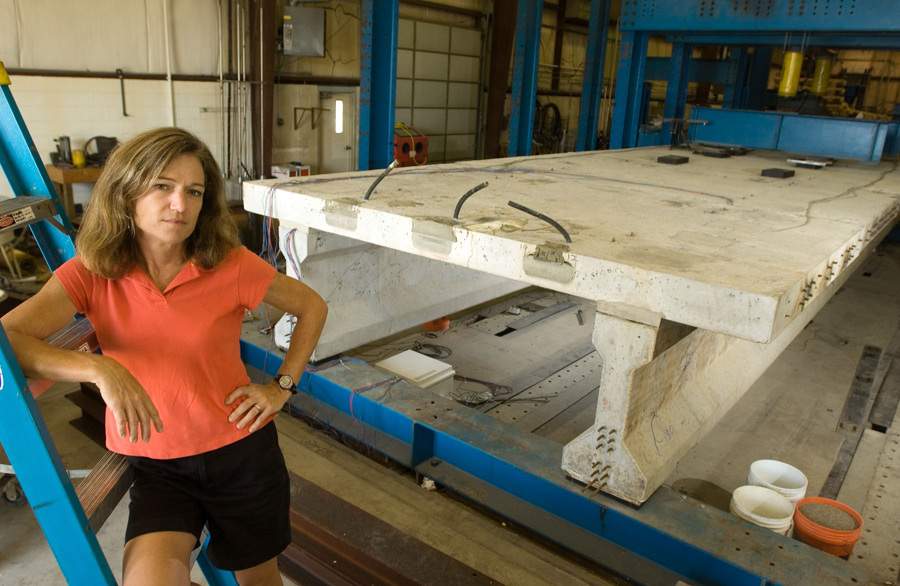Professor conducts research to build better bridges

Talk to Carin Roberts-Wollmann while she's conducting experiments and you might find her scratching what looks like hieroglyphics or cave drawings onto a concrete bridge. What she is actually doing is noting cracking and distress in a prototype bridge she’s constructed in the Structures and Materials Laboratory.
It’s part of her $334,000 grant from the Virginia Transportation Research Council entitled, “Detail and System Development for Full Depth Precast Concrete Bridge Deck Panels.”
It’s one of many projects Roberts-Wollmann, an associate professor in the Via Department of Civil and Environmental Engineering (CEE) in the College of Engineering, has worked on to net her the Precast/Prestressed Concrete Institute’s (PCI) 2006 Young Educator Achievement Award.
“When I won this award, I was really surprised,” said Roberts-Wollmann, an associate professor of civil and environmental engineering in the College of Engineering. The honor recognizes her contributions to the education and professional service to the precast/prestressed concrete industry. She received her award at the 2006 PCI Annual Convention in Grapevine, Texas. The award recognizes distinguished, young educators in the fields of engineering, architecture and construction technology who made significant contributions to the precast/prestressed concrete industry.
Roberts-Wollmann has been responsible for $1.15 million in research while at Virginia Tech. She’s also one of the researchers in the Cooperative Center for Bridge Engineering. All of her research has examined and analyzed new materials and/or new construction techniques that will create better bridges with improved durability and less maintenance, which translates into long-term savings for bridge builders.
That includes her latest research, looking into the behavior of a new full-depth, precast concrete bridge deck panel system. If the new construction method proves strong and durable, bridges could be built quicker and last longer than bridges built with conventional methods.
As an expert in concrete, the first thing Roberts-Wollmann will tell you about cement and concrete is they’re not the same. Concrete is a composite material made up primarily of cement, sand, coarse aggregate, and water. “And if the concrete is in tension, it may crack.”
To make up for the lack of tensile strength of concrete, the material can be placed over steel wire put under high stress. When the concrete cures, the wires are cut, and the wires pull back in on themselves and put the concrete in compression. The outcome is concrete less prone to cracking for bridge construction, which is known as prestressed concrete.
The bridge system Roberts-Wollmann is testing consists of two 36-inch deep prestressed concrete beams and five eight-foot long precast concrete bridge deck panels. The concrete panels were delivered to the lab with ducts within the slabs. The slabs are connected, and high strength steel strands are run through the ducts and then tensioned on site.
To test the bridge, Roberts-Wollmann’s using two 200-ton rams. She’s pushed the bridge to 360,000 pounds, and so far, the bridge is behaving as expected with all connection details performing well. Although her current research is not yet complete, it certainly looks promising. She hasn’t pushed the bridge to its breaking limit yet, but she anticipates doing that soon. In addition to the deck panel project, Roberts-Wollmann’s is also assisting on a $248,000 Federal Highway Administration grant investigating Grade 300 prestressing strands versus Grade 270 girder strands. She’s evaluating stress-strain behavior, yield strength, ultimate strength, ultimate strain, modulus of elasticity, and relaxation of the Grade 300 strands in hopes of identifying any issues in this higher strength strand.
Another project Roberts-Wollmann worked on included building a bridge in Franklin County, Va., using Glass Fiber Reinforced Polymer (GFRP) as top mat reinforcement. Steel reinforced concrete, as a bridge material, deteriorates because of exposure to the environment and de-icing chemicals. When the de-icing chemicals seep through the concrete and reach the steel reinforcing bars inside, corrosion occurs.
“Rust takes up more space than the steel, which exerts pressure on the concrete, said Roberts-Wollmann. “That’s why you start to get cracking, spalling and potholes. Then you have to patch or put down an overlay.”
So, instead of using the steel bars in the concrete slab, the Glass Fiber Reinforced Polymer was used instead, which does not corrode, in the slabs of the bridge. Instrumentation was installed in the deck and monitored during live load tests and for over two years after completion of construction.
The draw back of using Glass Fiber Reinforced Polymer is that it’s $5 more per square foot than the slabs with steel bars. But that extra money could buy you up to 20 years extra without an overlay. “Theoretically, it’s cheaper in the life cycle of the bridge,” added Roberts-Wollmann.



.jpg.transform/m-medium/image.jpg)
